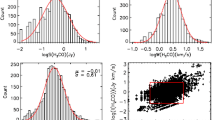Abstract
The data of the line series CH3CN 8(K) − 7(K) K = 0 − 7 and line CS J = 3 − 2 were taken simultaneously. At beam size of 16″ the emissions of CH3CN and CS have a common center position located near IRc2 with deviations Δα ∼ -8″ and Δδ ∼ 5″. The observed data show that in Orion KL core the integrated intensities of the two species have double peaks separated by a space of 14″. The 2-dimension Gaussian fitting plots (FWHM) are ellipses ofD maj = 26″ andD min = 22″ for CH3CN 8(K) − 7(K) K = 3 − 6 andD′maj = 39″ D′min = 31″ for CS J = 3 − 2 at a distance about 450 pc. Towards the multiple line emission region of CH3CN 8(K) − 7(K) K = 3 − 6, using a simplified very large velocity gradient model to solve the statistical equilibrium and radiative transfer equations, we find to fit the observed results, the optimum physical parameters and kinetic temperatureT k∼ 120 K, densityn(H a) ∼ 1.2 × 105 cm−3, velocity gradientV gr∼ 92 km s−1 pc−1 and the local abundance of CH3CNF ab∼ 3 × 10−8. However towards the region of single line emission of CS J = 3 − 2 we have to use LTE and the optical thin approximation on the assumption ofT k= 120 K to obtain the lower limits of column density and then, an averaged abundance of CS of 6 × 10−8.
Similar content being viewed by others
References
Boucher, D., Burie, J., Bauer, A., Dubrulle, A., and Demaison, J.: 1980,J. Phys. Chem. Ref. Data 9, 659.
Green, S.: 1988,Ap. J. 309, 331.
Habing, R.J. and Macdonald, G.H.: 1991,A&A 252, 705.
Hasegawa, T., Kaifu, N., Inatani, J., Morimoto, M., Chikada, Y., Hirabayashi, H., Iwashita, H., Morita, K.I., Tojo, A., and Akabane, K.: 1984,Ap. J. 283, 117.
Hollis, J.M.: 1982,Ap. J. 260, 159.
Loren, R.B., Mundy, L.G., and Erickson, N.R.: 1981,Ap. J. 250, 573.
Loren, R.B. and Mundy, L.G.: 1984,Ap. J. 286, 232.
Mezger, P.G., Wink, J.E., and Zylka, R.: 1990,A&A 228, 95.
Mundy, L.G., Cornwell, T.J., Masson, C.R., and Scoville, N.Z.: 1988,325, 382.
Pei, C.C. and Zeng, Q.: 1995,Acta Astronomica Sinica (a) 36 (1), 6 (b) 36 (2).
Stutzki, J. and Winnewisser, G.: 1985,A&A 144, 1.
Wange, T.Y., Wouterloot, J.G.A., and Wilson, T.L.: 1993,A&A 277, 205.
Zeng, Q., Sun, J., and Lou, G.F.: 1987,A&A 172, 299.
Author information
Authors and Affiliations
Rights and permissions
About this article
Cite this article
Zeng, Q., Pei, C.C. CH3CN J = 8 − 7 and CS J = 3 − 2 emission in orion KL. Astrophys Space Sci 229, 301–310 (1995). https://doi.org/10.1007/BF00626871
Received:
Accepted:
Issue Date:
DOI: https://doi.org/10.1007/BF00626871




